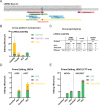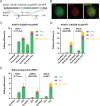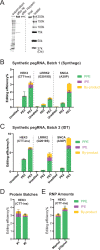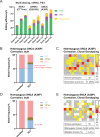Highly efficient generation of isogenic pluripotent stem cell models using prime editing
- PMID: 36069759
- PMCID: PMC9584603
- DOI: 10.7554/eLife.79208
Highly efficient generation of isogenic pluripotent stem cell models using prime editing
Abstract
The recent development of prime editing (PE) genome engineering technologies has the potential to significantly simplify the generation of human pluripotent stem cell (hPSC)-based disease models. PE is a multicomponent editing system that uses a Cas9-nickase fused to a reverse transcriptase (nCas9-RT) and an extended PE guide RNA (pegRNA). Once reverse transcribed, the pegRNA extension functions as a repair template to introduce precise designer mutations at the target site. Here, we systematically compared the editing efficiencies of PE to conventional gene editing methods in hPSCs. This analysis revealed that PE is overall more efficient and precise than homology-directed repair of site-specific nuclease-induced double-strand breaks. Specifically, PE is more effective in generating heterozygous editing events to create autosomal dominant disease-associated mutations. By stably integrating the nCas9-RT into hPSCs we achieved editing efficiencies equal to those reported for cancer cells, suggesting that the expression of the PE components, rather than cell-intrinsic features, limit PE in hPSCs. To improve the efficiency of PE in hPSCs, we optimized the delivery modalities for the PE components. Delivery of the nCas9-RT as mRNA combined with synthetically generated, chemically-modified pegRNAs and nicking guide RNAs improved editing efficiencies up to 13-fold compared with transfecting the PE components as plasmids or ribonucleoprotein particles. Finally, we demonstrated that this mRNA-based delivery approach can be used repeatedly to yield editing efficiencies exceeding 60% and to correct or introduce familial mutations causing Parkinson's disease in hPSCs.
Keywords: disease models; genetics; genome engineering; genomics; hPSCs; human; parkinson's disease; prime editing; regenerative medicine; stem cells.
Plain language summary
From muscles to nerves, our body is formed of many kinds of cells which can each respond slightly differently to the same harmful genetic changes. Understanding the exact relationship between mutations and cell-type specific function is essential to better grasp how conditions such as Parkinson’s disease or amyotrophic lateral sclerosis progress and can be treated. Stem cells could be an important tool in that effort, as they can be directed to mature into many cell types in the laboratory. Yet it remains difficult to precisely introduce disease-relevant mutations in these cells. To remove this obstacle, Li et al. focused on prime editing, a cutting-edge ‘search and replace’ approach which can introduce new genetic information into a specific DNA sequence. However, it was unclear whether this technique could be used to efficiently create stem cell models of human diseases. A first set of experiments showed that prime editing is superior to conventional approaches when generating mutated genes in stem cells. Li et al. then further improved the efficiency and precision of the method by tweaking how prime editing components are delivered into the cells. The refined approach could be harnessed to quickly generate large numbers of stem cells carrying mutations associated with Parkinson’s disease; crucially, prime editing could then also be used to revert a mutated gene back to its healthy form. The improved prime editing approach developed by Li et al. removes a major hurdle for scientists hoping to use stem cells to study genetic diseases. This could potentially help to unlock progress in how we understand and ultimately treat these conditions.
© 2022, Li, Busquets et al.
Conflict of interest statement
HL, OB, YV, KS, NK, GP, LG, HB, DR, DH, FS No competing interests declared
Figures










Similar articles
-
Optimized Prime Editing of Human Induced Pluripotent Stem Cells to Efficiently Generate Isogenic Models of Mendelian Diseases.Int J Mol Sci. 2024 Dec 26;26(1):114. doi: 10.3390/ijms26010114. Int J Mol Sci. 2024. PMID: 39795970 Free PMC article.
-
Efficient Generation and Correction of Mutations in Human iPS Cells Utilizing mRNAs of CRISPR Base Editors and Prime Editors.Genes (Basel). 2020 May 6;11(5):511. doi: 10.3390/genes11050511. Genes (Basel). 2020. PMID: 32384610 Free PMC article.
-
Bi-PE: bi-directional priming improves CRISPR/Cas9 prime editing in mammalian cells.Nucleic Acids Res. 2022 Jun 24;50(11):6423-6434. doi: 10.1093/nar/gkac506. Nucleic Acids Res. 2022. PMID: 35687127 Free PMC article.
-
Prime editing: a search and replace tool with versatile base changes.Yi Chuan. 2022 Nov 20;44(11):993-1008. doi: 10.16288/j.yczz.22-156. Yi Chuan. 2022. PMID: 36384993 Review.
-
Insights into Prime Editing Technology: A Deep Dive into Fundamentals, Potentials, and Challenges.Hum Gene Ther. 2024 Sep;35(17-18):649-668. doi: 10.1089/hum.2024.043. Epub 2024 Jul 1. Hum Gene Ther. 2024. PMID: 38832869 Review.
Cited by
-
MutSα and MutSβ as size-dependent cellular determinants for prime editing in human embryonic stem cells.Mol Ther Nucleic Acids. 2023 May 18;32:914-922. doi: 10.1016/j.omtn.2023.05.015. eCollection 2023 Jun 13. Mol Ther Nucleic Acids. 2023. PMID: 37346976 Free PMC article.
-
Reducing the inherent auto-inhibitory interaction within the pegRNA enhances prime editing efficiency.Nucleic Acids Res. 2023 Jul 21;51(13):6966-6980. doi: 10.1093/nar/gkad456. Nucleic Acids Res. 2023. PMID: 37246708 Free PMC article.
-
Robust and inducible genome editing via an all-in-one prime editor in human pluripotent stem cells.Nat Commun. 2024 Dec 30;15(1):10824. doi: 10.1038/s41467-024-55104-1. Nat Commun. 2024. PMID: 39737975 Free PMC article.
-
Pluripotent Stem Cells as a Preclinical Cellular Model for Studying Hereditary Spastic Paraplegias.Int J Mol Sci. 2024 Feb 23;25(5):2615. doi: 10.3390/ijms25052615. Int J Mol Sci. 2024. PMID: 38473862 Free PMC article. Review.
-
Enhancing genome editing in hPSCs through dual inhibition of DNA damage response and repair pathways.Nat Commun. 2024 May 11;15(1):4002. doi: 10.1038/s41467-024-48111-9. Nat Commun. 2024. PMID: 38734692 Free PMC article.
References
Publication types
MeSH terms
Substances
Grants and funding
LinkOut - more resources
Full Text Sources
Other Literature Sources
Research Materials

